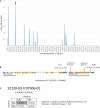Genome sequencing of adapted diploid potato clones
- PMID: 36003817
- PMCID: PMC9394749
- DOI: 10.3389/fpls.2022.954933
Genome sequencing of adapted diploid potato clones
Abstract
Cultivated potato is a vegetatively propagated crop, and most varieties are autotetraploid with high levels of heterozygosity. Reducing the ploidy and breeding potato at the diploid level can increase efficiency for genetic improvement including greater ease of introgression of diploid wild relatives and more efficient use of genomics and markers in selection. More recently, selfing of diploids for generation of inbred lines for F1 hybrid breeding has had a lot of attention in potato. The current study provides genomics resources for nine legacy non-inbred adapted diploid potato clones developed at Agriculture and Agri-Food Canada. De novo genome sequence assembly using 10× Genomics and Illumina sequencing technologies show the genome sizes ranged from 712 to 948 Mbp. Structural variation was identified by comparison to two references, the potato DMv6.1 genome and the phased RHv3 genome, and a k-mer based analysis of sequence reads showed the genome heterozygosity range of 1 to 9.04% between clones. A genome-wide approach was taken to scan 5 Mb bins to visualize patterns of heterozygous deleterious alleles. These were found dispersed throughout the genome including regions overlapping segregation distortions. Novel variants of the StCDF1 gene conferring earliness of tuberization were found among these clones, which all produce tubers under long days. The genomes will be useful tools for genome design for potato breeding.
Keywords: StCDF1; breeding; deleterious alleles; diploid potato; genome sequencing; potato.
Copyright © 2022 Achakkagari, Kyriakidou, Gardner, De Koeyer, De Jong, Strömvik and Tai.
Conflict of interest statement
The authors declare that the research was conducted in the absence of any commercial or financial relationships that could be construed as a potential conflict of interest.
Figures







Similar articles
-
Leveraging a phased pangenome for haplotype design of hybrid potato.Nature. 2025 Apr;640(8058):408-417. doi: 10.1038/s41586-024-08476-9. Epub 2025 Jan 22. Nature. 2025. PMID: 39843749 Free PMC article.
-
Phased, chromosome-scale genome assemblies of tetraploid potato reveal a complex genome, transcriptome, and predicted proteome landscape underpinning genetic diversity.Mol Plant. 2022 Mar 7;15(3):520-536. doi: 10.1016/j.molp.2022.01.003. Epub 2022 Jan 10. Mol Plant. 2022. PMID: 35026436
-
Genome evolution and diversity of wild and cultivated potatoes.Nature. 2022 Jun;606(7914):535-541. doi: 10.1038/s41586-022-04822-x. Epub 2022 Jun 8. Nature. 2022. PMID: 35676481 Free PMC article.
-
Applications of biotechnology and genomics in potato improvement.Plant Biotechnol J. 2013 Oct;11(8):907-20. doi: 10.1111/pbi.12099. Epub 2013 Aug 7. Plant Biotechnol J. 2013. PMID: 23924159 Review.
-
Breeding Diploid F1 Hybrid Potatoes for Propagation from Botanical Seed (TPS): Comparisons with Theory and Other Crops.Plants (Basel). 2022 Apr 21;11(9):1121. doi: 10.3390/plants11091121. Plants (Basel). 2022. PMID: 35567122 Free PMC article. Review.
Cited by
-
Exploring intra- and intergenomic variation in haplotype-resolved pangenomes.Plant Biotechnol J. 2025 Mar;23(3):874-886. doi: 10.1111/pbi.14545. Epub 2025 Jan 5. Plant Biotechnol J. 2025. PMID: 39756800 Free PMC article.
-
Jan and mini-Jan, a model system for potato functional genomics.Plant Biotechnol J. 2025 Apr;23(4):1243-1256. doi: 10.1111/pbi.14582. Epub 2025 Jan 23. Plant Biotechnol J. 2025. PMID: 39846980 Free PMC article.
-
Pangenome analyses reveal impact of transposable elements and ploidy on the evolution of potato species.Proc Natl Acad Sci U S A. 2023 Aug;120(31):e2211117120. doi: 10.1073/pnas.2211117120. Epub 2023 Jul 24. Proc Natl Acad Sci U S A. 2023. PMID: 37487084 Free PMC article.
-
Analysis of Genome Structure and Its Variations in Potato Cultivars Grown in Russia.Int J Mol Sci. 2023 Mar 16;24(6):5713. doi: 10.3390/ijms24065713. Int J Mol Sci. 2023. PMID: 36982787 Free PMC article.
-
Diploid inbred-based hybrids: fast-forward breeding approach in potatoes.Physiol Mol Biol Plants. 2024 Dec;30(12):1955-1968. doi: 10.1007/s12298-024-01544-4. Epub 2024 Dec 24. Physiol Mol Biol Plants. 2024. PMID: 39744324 Review.
References
-
- Bethke P. C., Halterman D. A., Jansky S. H. (2019). Potato Germplasm Enhancement Enters the Genomics Era. Agronomy 9:575. 10.3390/agronomy9100575 - DOI
-
- Bradshaw J. E. (2021). “Introgression, Base Broadening and Potato Population Improvements,” in Potato Breeding: Theory and Practice, ed. Bradshaw J. E. (Cham: Springer International Publishing; ), 341–403. 10.1007/978-3-030-64414-7_6 - DOI
Associated data
LinkOut - more resources
Full Text Sources
Miscellaneous

